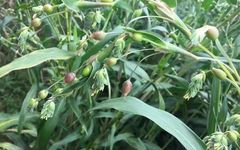Coix Seed (Yi Yi Ren) is the dried mature seed of the plant Coix lacryma-jobi L. var. mayuen (Roman.) Stapf, belonging to the family Poaceae. The plant is harvested in autumn when the fruits are ripe, dried, and the seeds are separated from the fruit, then further dried to remove the outer shell, yellow-brown seed coat, and impurities, collecting the seeds.

Coix Plant
【Characteristics】 The product is broad oval or long oval in shape, measuring 4-8mm in length and 3-6mm in width. The surface is milky white and smooth, occasionally with remnants of yellow-brown seed coat; one end is blunt and rounded, while the other end is wider and slightly concave, with a light brown dot-like hilum; the back is rounded and convex, and the belly has a wide and deep longitudinal groove. The texture is solid, with a white cross-section that is powdery. It has a slight aroma and a mildly sweet taste.
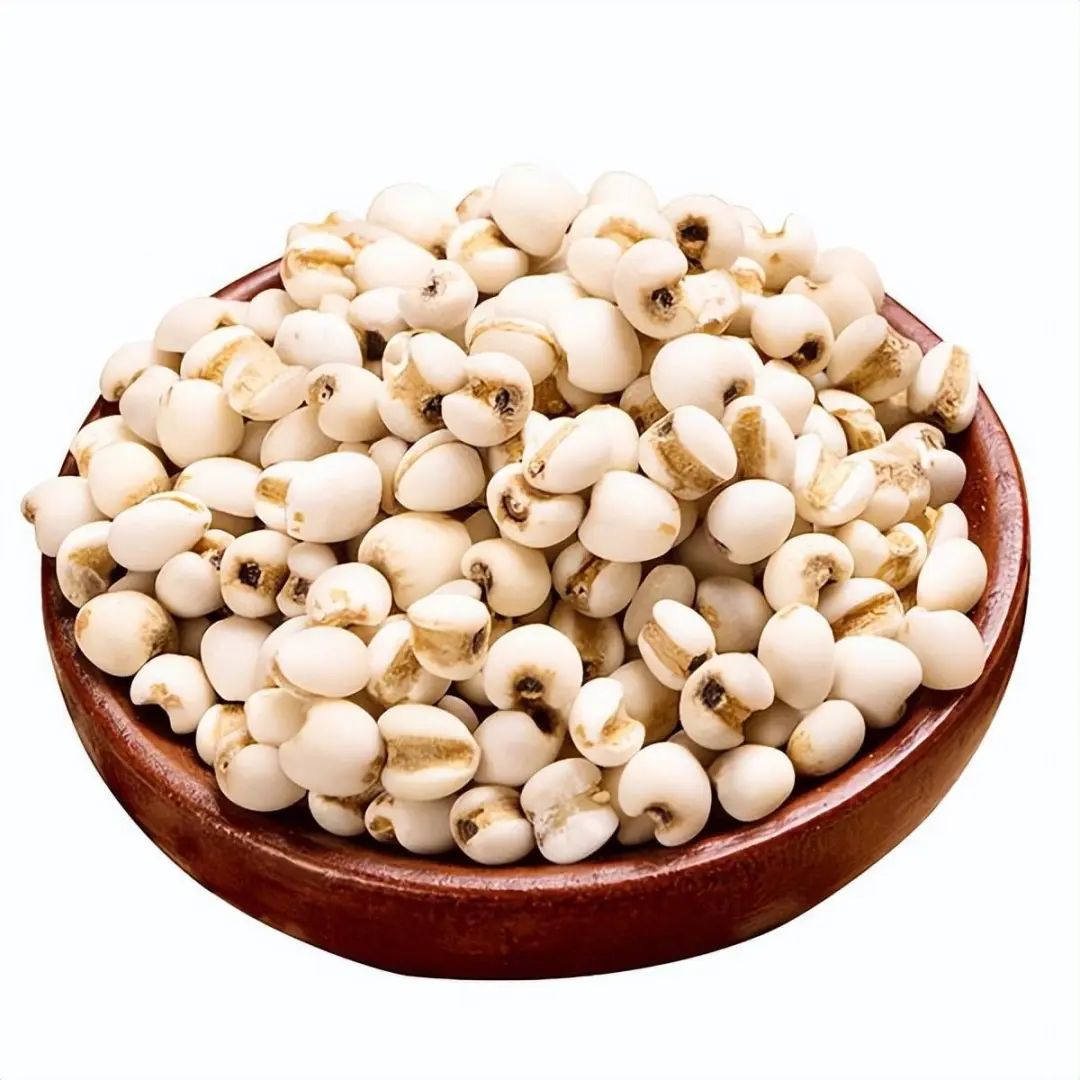
Coix Seed Material
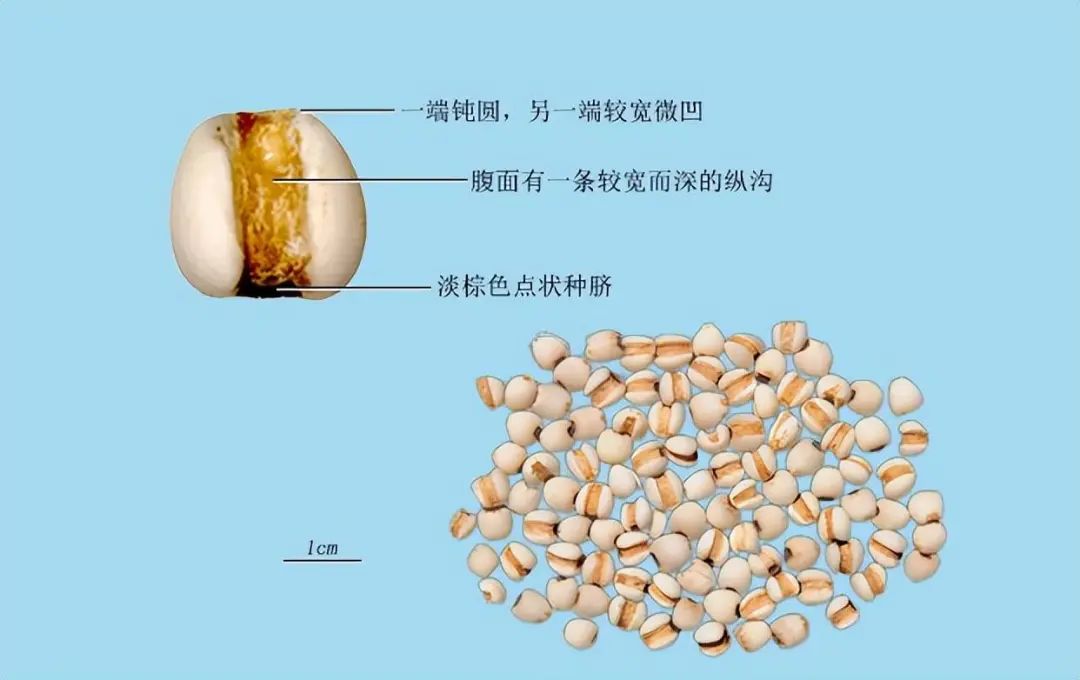
Identification of Coix Seed Characteristics
Imitations: Grass Pearl
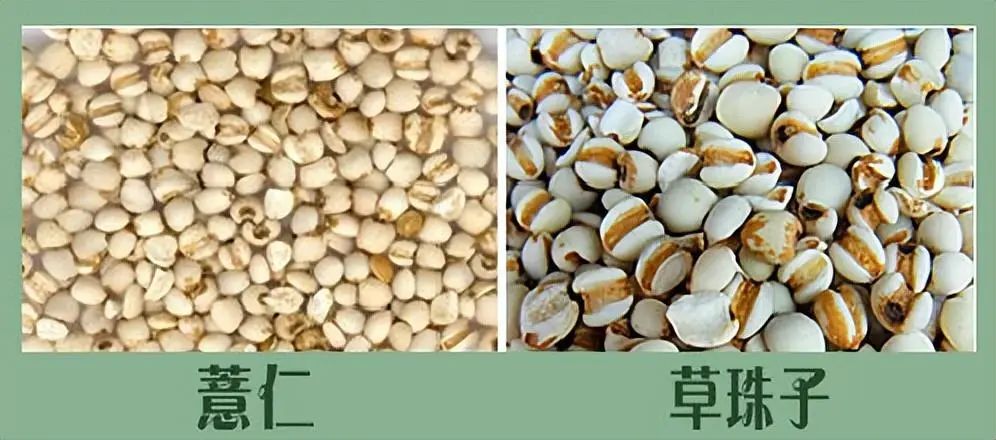
Comparison of Coix Seed and Grass Pearl
True and False Coix Seed
Identification Method: Coix Seed is longer than it is wide and relatively small. Grass Pearl seeds are wider than they are long and larger than Coix Seeds.
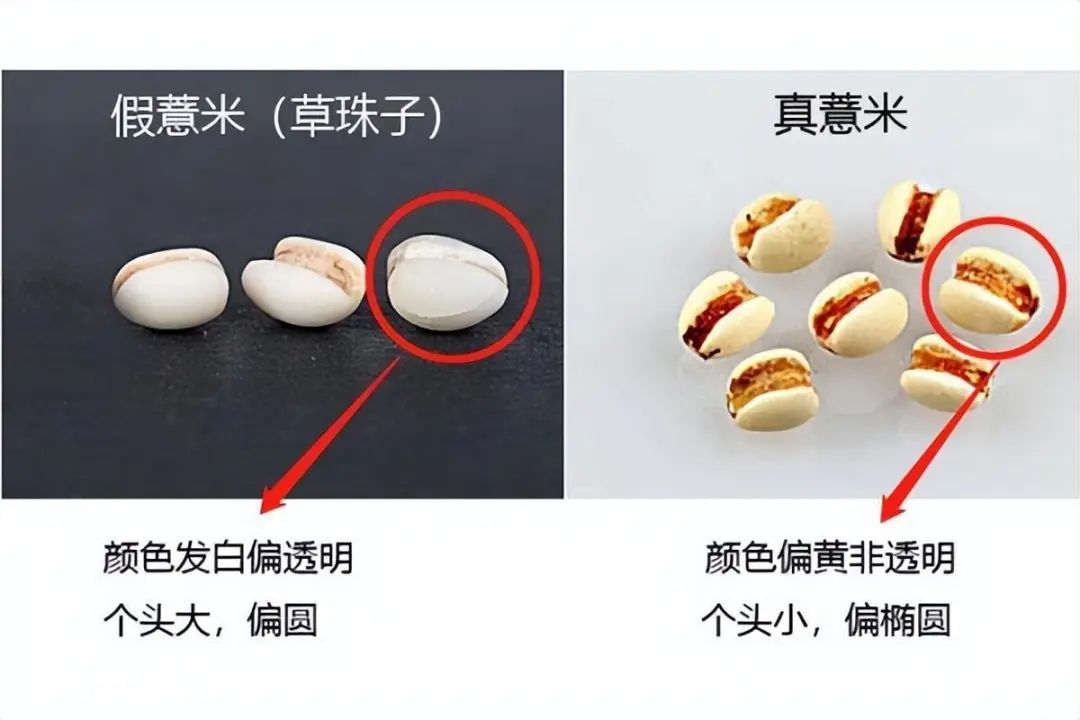
Comparison of Coix Seed and Grass Pearl
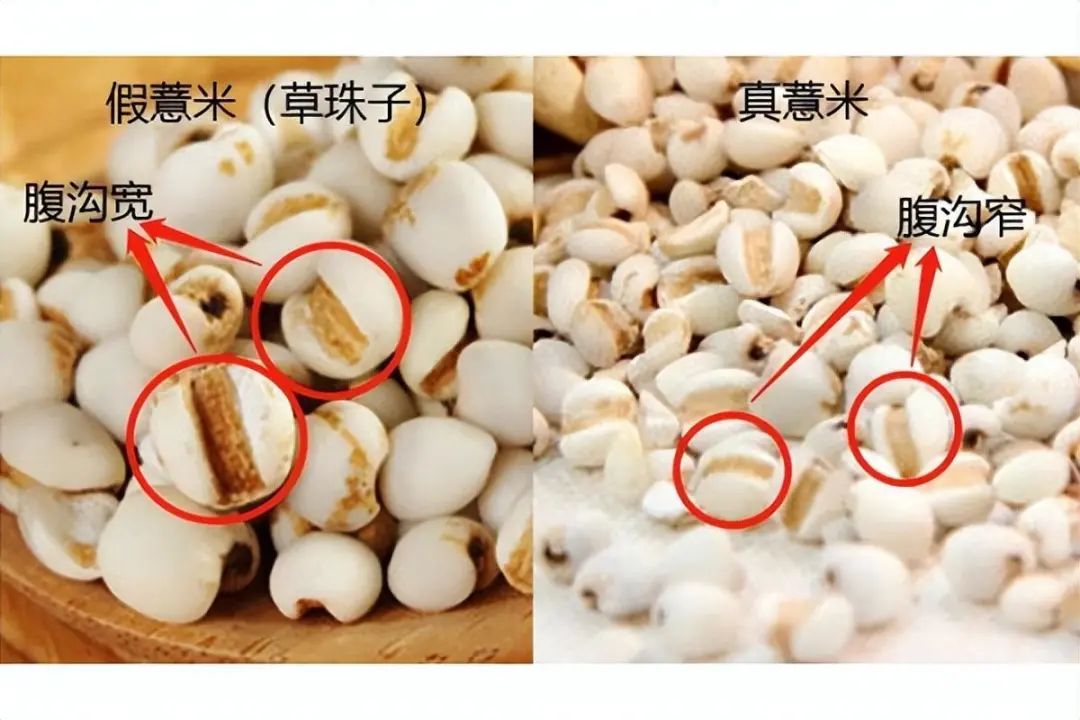
Comparison of Coix Seed and Grass Pearl
Imitation: White Sorghum
1. Coix Seed
Appearance is broad oval or long oval, measuring 0.4-0.8 cm in length and 0.3-0.6 cm in width, with a white or yellow-white surface, occasionally with remnants of yellow-brown outer skin. One end is blunt and rounded, while the other end is wider and slightly concave, with a light brown dot-like hilum. The back is rounded and convex, and the belly has a wide and deep longitudinal groove, with a rough bottom and a smooth or slightly striated surface. The cross-section is white and powdery; it has a slight aroma and a mildly sweet taste.
2. White Sorghum
Appearance is nearly flat round or long oval, slightly raised on both sides, measuring 0.3-0.6 cm in length and about 0.3 cm in diameter, with a milky white or gray-white surface, one side having a shallow indentation about half the diameter. The cross-section is whitish and slightly powdery; it has a slight aroma but a slightly astringent taste with a hint of sweetness.
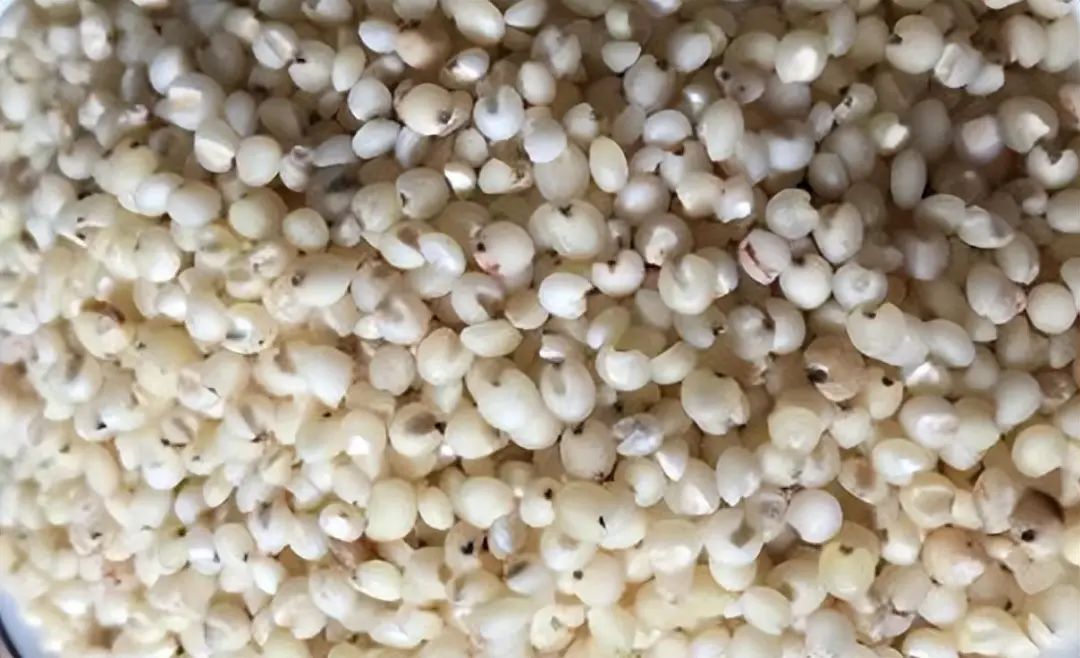
Imitation: White Sorghum
【Processing】 Fried Coix Seed Take clean Coix Seed and fry it according to the method (General Method 0213) until it turns slightly yellow.
【Characteristics】 The product resembles Coix Seed, slightly bulging, with a surface that is slightly yellow.

Fried Coix Seed
【Chemical Composition】
Coix Seed contains eight essential amino acids required by the human body, with proportions very close to human needs. It has been measured that every 100g of Coix Seed contains approximately 9.4g of protein, 2.7g of fat, 66.5g of carbohydrates, 0.33g of VB1, 0.13g of VB2, 7.9mg of niacin, 0.22mg of vitamin E, and 4.9g of dietary fiber. Coix Seed also contains mineral elements such as phosphorus, iron, calcium, zinc, and potassium.
Coix Seed contains 7.2% of lipid substances, with the main components being coixenolide, coixolide, steroid compounds, sitosterol, stigmasterol, and stearic acid, among which the content of various unsaturated fatty acids is 85%, with oleic acid and linoleic acid accounting for 51.6% and 32.2% of the total fatty acids, respectively.
Coix Oil
Research indicates that the main components of Coix Oil include coixenolide, triglycerides (including triglyceride oleate, triglyceride linoleate, 1,2-oleate-3-linoleate triglyceride, 1,2-linoleate-3-oleate triglyceride, etc.), coixolide (also known as coixenolide), palmitic acid, stearic acid, octadecenoic acid, octadecadienoic acid, long-chain fatty acids (pentadecanoic acid, eicosanoic acid, docosanoic acid, docosahexaenoic acid, tricosanoic acid, tetracosanoic acid), myristic acid, and stearic acid esters, palmitic acid esters, sterols (campesterol, ergosterol, sitosterol, β-sitosterol, α-sitosterol, cholesterol, etc.), squalene, vitamin E, and others.
Carbohydrates
In addition to various lipid components, Coix Seed also contains a large amount of starch and sugars. The active polysaccharides in Coix Seed are mostly non-sulfated acetylamino polysaccharides. Currently, it is known that the sugars in Coix Seed mainly consist of starch, Coix polysaccharide A [(composed of rhamnose: arabinose: xylose: mannose: galactose (1:1:1:11:10)], B [(composed of rhamnose: arabinose: xylose: mannose: galactose: glucose (3:18:13:3:10:5)], C (glucan), neutral polysaccharides 1-7, and acidic polysaccharides CA-1 and CA-2, etc.
Proteins
The protein (12.18%-16.65%), active peptides, and amino acids in Coix Seed form the basis of its nutritional functions and pharmacological effects. The main storage protein in Coix Seed is alcohol-soluble protein, which contains eight essential amino acids required by humans in proportions close to those needed by the body. LIN et al. confirmed the sequence of alcohol-soluble protein in Coix Seed through expression sequence tag methods and analyzed the amino acid composition of the three subunits of alcohol-soluble protein using MS, showing that the amino acid composition ratios differ among the subunits, but all are rich in glutamic acid, with high contents of methionine, cysteine, lysine, and histidine, making it a good nutritional supplement compared to other grains.
Mineral Elements
Although the mineral element content in Coix Seed is relatively low, the variety is high, with 29 elements measured, which are essential for maintaining physiological functions and immune health. Analysis of the mineral element content in Guizhou Coix Seed shows that Mg, Ca, Fe, and Zn are relatively abundant, especially Fe and Zn, which are significantly higher than in general grains. Coix Seed has high levels of Mg and Ca.
Others
Coix Seed also contains various B vitamins, vitamin C, and dietary fiber.
【Pharmacological Effects】
1. Antitumor It has been confirmed that components such as Coix Oil and coixenolide (CXL) in Coix Seed have antitumor effects, such as inhibiting cancer cell metastasis and proliferation, inducing cancer cell apoptosis, inhibiting tumor angiogenesis, and enhancing sensitivity during radiation therapy. Kanglaite Injection (KLT) is a widely used clinical antitumor drug, primarily composed of Coix Oil, which has good therapeutic or adjuvant effects on liver cancer, gastric cancer, colon cancer, lung cancer, pancreatic cancer, nasopharyngeal cancer, and kidney cancer.
2. Immune Regulation Studies have shown that coixenolide and Coix polysaccharides can significantly promote the production of antibodies by peripheral blood mononuclear cells in healthy individuals, enhance lymphocyte transformation, and boost humoral and cellular immunity. Miao Mingsan used cyclophosphamide on mice to reduce their immune capacity, and after administering Coix polysaccharide aqueous solution, it was found that Coix polysaccharide significantly increased the phagocytosis percentage and index of peritoneal macrophages in mice, promoting the formation of hemolysin and hemolytic plaques, and enhancing lymphocyte transformation, indicating that Coix polysaccharide has good immune-stimulating effects. Wang Liming used Coix Oil and Coix polysaccharide on D-galactose-induced aging mice, measuring the levels of interleukin-6, interferon-γ, and tumor necrosis factor-α in the blood, as well as the expression of interleukin-10 and cytokine 28 mRNA in liver tissue, finding that both Coix Oil and Coix polysaccharide could reduce serum interleukin-6 levels while increasing interferon-γ levels, decreasing interleukin-10 mRNA expression while promoting cytokine 28 mRNA expression; only Coix Oil could elevate serum tumor necrosis factor-α levels, indicating that both Coix Oil and Coix polysaccharide can enhance T cell immune function and have certain anti-aging effects.
3. Blood Sugar and Lipid Lowering Coix Seed contains hydroxyl unsaturated fatty acids and polysaccharides that have blood sugar and lipid-lowering effects, making it a commonly used medicine in TCM for treating diabetes and its complications, as well as cardiovascular and cerebrovascular diseases. Xu Zihui et al. found that Coix polysaccharide can improve abnormal glucose and lipid metabolism in diabetic rats and has a protective effect on pancreatic cell damage caused by alloxan. Based on this, they studied its effect on the expression of endothelin-1 mRNA in the aorta of type 2 diabetic rats, finding that Coix polysaccharide can inhibit the upregulation of endothelin-1 mRNA. Huang et al. added Coix Oil to the diet of rats, finding that Coix Oil can lower low-density lipoprotein cholesterol levels and reduce leptin content. Yu Fei found that administering Coix extract to hyperlipidemic rats can lower serum cholesterol and low-density lipoprotein cholesterol concentrations and enhance the total antioxidant capacity of the rats by scavenging free radicals and reactive oxygen species, proving that Coix extract can be used to prevent and treat atherosclerosis and coronary heart disease.
4. Anti-inflammatory, Analgesic, and Hemostatic Components such as coixenolide and β-sitosterol in Coix Seed have analgesic, anti-inflammatory, and hemostatic effects. Gao Lan et al. applied homemade Coix soup to mice, studying the pain threshold at different times using the hot plate method, the number of writhes induced by acetic acid, and the degree of ear swelling induced by xylene, while also studying the effects of Coix soup on rat egg white arthritis, cotton ball granuloma, capillary permeability, and the content of prostaglandin E2 in inflammatory tissues, showing that Coix has inhibitory effects on inflammation and pain. Tao Xiaojun et al. injected Coix Oil into mice, observing its effects on pain, bleeding time, and coagulation time through the writhing method, tail clipping method, and capillary glass tube method, showing that Coix Oil significantly prolonged the latency of writhing, reduced the number of writhes, decreased bleeding time, and shortened coagulation time, proving that Coix Oil has analgesic and hemostatic effects.
5. Others Coix Seed also has effects in inhibiting osteoporosis, alleviating fatigue, regulating the reproductive system, and treating skin diseases.
【Taste and Meridian Entry】 Sweet, bland, and cool. It enters the Spleen, Stomach, and Lung meridians.
【Functions and Indications】 Promotes diuresis and dampness elimination, strengthens the Spleen and stops diarrhea, alleviates pain, drains pus, detoxifies, and disperses masses. Used for edema, beriberi, difficult urination, Spleen deficiency diarrhea, dampness obstruction, lung abscess, intestinal abscess, warts, and tumors.
【Dosage】 9-30g.
【Precautions】 Use with caution in pregnant women.
【Storage】 Store in a ventilated and dry place, preventing insect damage.
Note:This article aims to promote Traditional Chinese Medicine culture, and the TCM knowledge mentioned is for learning and exchange purposes only.
WeChat has been updated! If youneither★starred me,nor liked or “viewed” my articles, the system will assume you do not wish to receive information related to herbal medicine knowledge, and ultimatelyyou will not receive our article updates
End of Article. Thank you for your patience in reading. If you find it good, please click “ like” and “
like” and “ view” at the bottom~
view” at the bottom~
As the saying goes, “When three people walk together, there must be a teacher among them.” To facilitate the integration and exchange of knowledge among TCM practitioners, we are preparing to establish a group for herbal medicine knowledge. If you wish to join, please add the editor on WeChat and specify your identity. The editor invites you to join the group.


